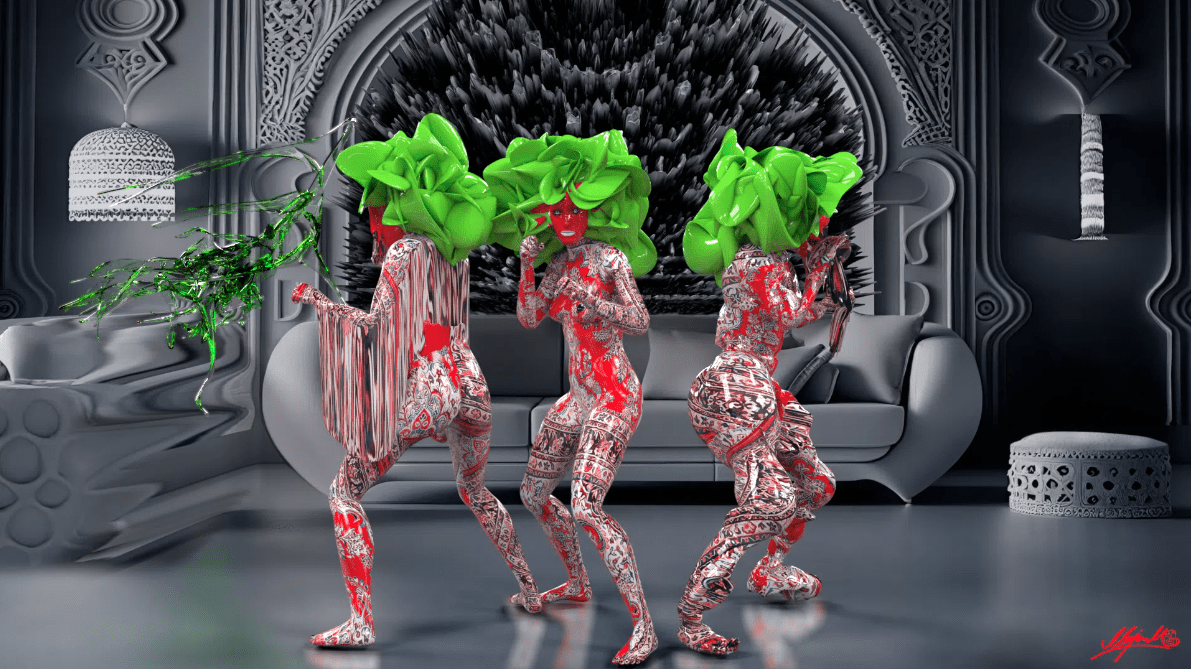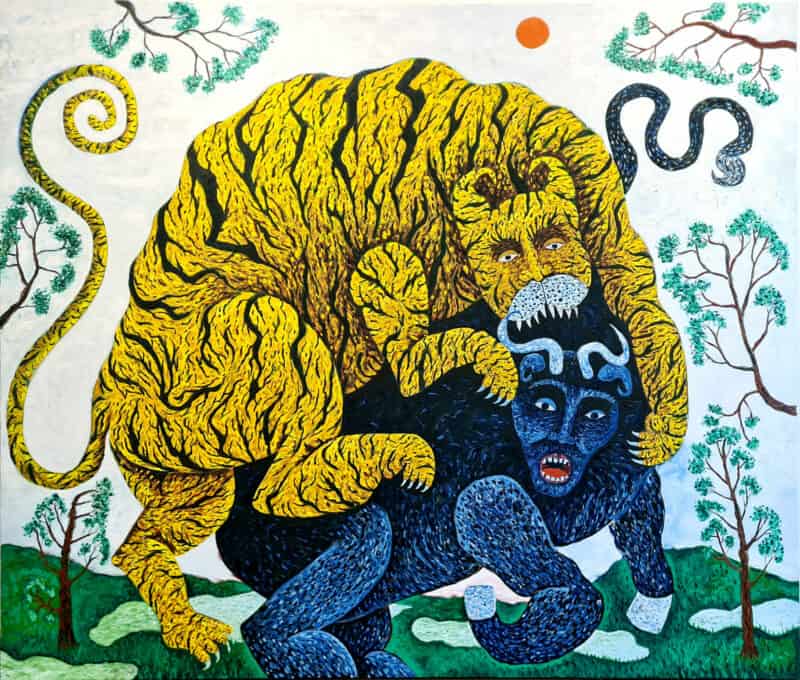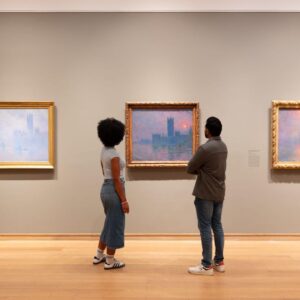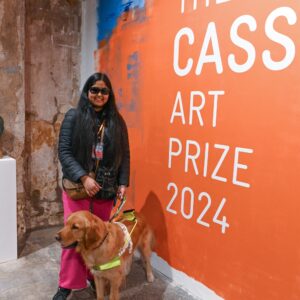There’s a total deluge hammering down on East London for the opening of Annka Kultys’ latest show. It’s a joint presentation of works by painter Juliette Sturlèse and digital artist Marjan Moghaddam, shown across a mix of media split between the gallery floor and its new 10,000 sq ft virtual space. There’s a VR headset by the entrance by the corner. I can’t wait to get in; even though spring is around the corner I’m drenched to the bone and freezing. The works on show here are all about feeling out of place; whether it’s the three-dimensional interjections of astroturf (symbolic pubic hair) on Sturlèse’s canvases protruding out of a flat plain or that Moghaddam’s work is best understood with the headset on for the full audio-visual pop-inflected bombardment it offers, walking around it’s easy to relate. I guess everyone else brought their
umbrella.

Sturlèse first, it’s too tempting to get away from the weather so I’ve headed straight to the back of the gallery. The work depicts these huge abstract shapes, greens and blues which look startlingly like aerial shots of suburban gardens at low resolution. ‘A little mouse was running through the grass’ is her title for the work, the paintings said to signify a journey through memory, isolated and pocketed expressions of ideation that come to form a landscape in the unconscious mind. On the night I’m inclined to relate to the titular rodent; the marks on the canvas playing nicely into ideas of the unbalanced power dynamic between a creature that has come to feel very small and its overwhelming environment. It’s hard to peel your eyes away from eating up all the little details; trying to parse the instability; grabbing at ideas that resist, remain vague and challenge you. The rain clatters down outside, and someone makes a joke about a drowned rat, somewhat reinforcing this; it’s exactly how I feel.
That being said, there’s an escapist undertone to the whole thing too. Rat metamorphosis aside, I can’t get away from the idea that I’m seeing a bird’s-eye view. In the blue oblongs, there are swimming pools and sun loungers, beside them patios and parasols, the sea and grass brush (aforementioned astroturf). A few of the works even have thin blue moats around them, providing a border, making an island out of a memory. That’s how we like to treat memories, the nice ones; as perfect little spaces we can go back to, crawl inside; try again and again to refine, clarify, and shape. ‘Pelouse au soleil’ depicts a lawn on a summer’s day to just this sensation of comfort; creating a place where it is warm and dried out, safe and sound. There’s a temptation to read this kind of nostalgia, idealism, as a kind of rejection or interruption too; invasion of the
personal into the present surroundings and vice versa. Perhaps that’s why Sturlèse’s memories are vague, the forms abstract; because once a moment has passed one can no longer truly belong there.

Accelerating chronologically, technologically, and possibly physically because the line for the VR headset has finally cleared (the gallery has found an immediate hit in its extended virtual floor), I’ve got to hurry to catch Moghaddam’s work in full swing. ‘Intervention as Digital Embodiment’ is being shown on a pair of sizeable tv screens, but once plugged into the Annka Kultys PHYGITAL digital gallery you get the full experience. Disorienting for the uninitiated, but easy to get the hang of, the rooms inside are just packed with digital sculptures, all morphing and stretching out of shape in ways unique to the medium of cyberspace. Most are female figures, those in the ‘For Freedom’ series and ‘Woman, Life, Freedom AI’ painted in the bright greens and reds of the Iranian flag, in feminist protest against the state’s prejudice and abuses of power. All are considered #Arthacks, which come overlayed onto footage of global art shows (now recreated via 3-D modelling), her bodies invading the spaces to have their say whether or not they have been gifted displays of their own. Moghaddam’s work is both eerie and powerfully cathartic to witness. The infusion of each piece with remixed old Iranian revolutionary songs
provokes instant pop-music emotion, while the figures’ superimposition onto pre-recorded footage is distinctly uncanny, given their lack of register by the films’ human actors. It’s these parallax motions, the two themes of her work grinding against each other that produces its drama, and hooks you from the first moment. It is protest, political art, a visual feast, and yet shoulders a kind of pathos that lingers and extrudes from the ghost-like digital bodies. They call for attention, they have cause and passion and demand to be noticed, yet remain unheard. They are outsiders, trying to get in. One hopes that visitors to Annka Kultys gallery will provide the attention they crave, and the debate they want to stimulate.
As the opening continues, the guests all bump into one another. Over the course of the evening, they each find old acquaintances, make new ones, and drink beers. It’s getting more crowded now than I’ve ever seen it; the line to dive into VR for Moghaddam’s sculpture is longer than ever, and there’s a row of heads and shoulders packed tightly around Sturlèse’s work that has been there so long it’s tempting to consider them part of the paintings. Some of the new guests are just as soaked as I was getting in. It’s still raining outside. There’s something thrilling about sticking out, feeling different, when the people around you feel just the same.







